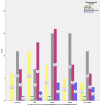Attitudes of People With Chronic Musculoskeletal Disorders Towards Telerehabilitation: A Cross-Sectional Survey
- PMID: 40741549
- PMCID: PMC12308257
- DOI: 10.7759/cureus.87012
Attitudes of People With Chronic Musculoskeletal Disorders Towards Telerehabilitation: A Cross-Sectional Survey
Abstract
Introduction Chronic musculoskeletal disorders have a significant impact on morbidity, daily functioning, and quality of life. They represent a key priority for intervention, particularly in the context of an aging population and increased life expectancy. Recently, telerehabilitation has been shown to be effective; however, the attitudes of this clinical population toward telerehabilitation have not yet been thoroughly explored in the literature. The aim of this study was to investigate the knowledge, beliefs, and willingness of people with chronic musculoskeletal disorders in Greece to use telerehabilitation. Materials and methods In this cross-sectional study, 160 individuals (95 women and 65 men) with a mean age of 44.1 years and diagnosed with chronic musculoskeletal problems completed a survey. The sample included participants with low back pain (56, 36.9%), overuse tendinopathies (30, 18.8%), neck pain (34, 21.3%), arthritis (14, 8.8%), and upper back pain (3, 1.9%). Participants were recruited from physiotherapy clinics in Athens. The study protocol was approved by the Ethical Committee of the University of West Attica, Greece. The survey questionnaire included 26 items (16 general and 10 telerehabilitation-specific) covering demographic background, familiarization with technology, overall perceptions, willingness to follow telerehabilitation, and preferred mode of delivery. Results The survey was first pilot-tested, and relevant modifications were made. The final version demonstrated acceptable internal consistency (Cronbach's alpha = 0.648). Principal Components Analysis (PCA) revealed a three-factor solution, familiarization with technology, preferred mode of telerehabilitation, and willingness to attend telerehabilitation, with eigenvalues of 2.19, 1.98, and 1.22 respectively, explaining 53.97% of total variance. Overall, fewer than half of the participants (59, 36.9%) reported willingness to follow telerehabilitation. The preferred mode of delivery was video-based sessions. Their perspective towards telerehabilitation appeared to be related to seeking information about their problem online (X2 (4, N=160)= 11.1, p=0.03) and technological familiarity (Likelihood Ratio, p=0.048) but not with the specific type of musculoskeletal condition (X2 (16, N=160)=12.7, p=ns). Conclusion Telerehabilitation, which leverages technology to deliver rehabilitation services remotely, is indeed seeing its culture constructed and integrated into healthcare systems. However, this survey highlights barriers based on patient attitudes, as less than half of respondents were receptive to the approach. Higher education levels, greater familiarity with technology, and a tendency to seek medical information online were associated with a greater willingness to engage in telerehabilitation. Further research involving larger samples and populations from rural areas across Greece is needed to assess the generalizability of these findings, particularly in regions where health equity is challenged by limited access and technological disparities.
Keywords: attitudes; chronic musculoskeletal disorders; pain management; physiotherapy; survey; tele-physiotherapy; telerehabilitation.
Copyright © 2025, Tsolakou et al.
Conflict of interest statement
Human subjects: Informed consent for treatment and open access publication was obtained or waived by all participants in this study. Research Ethics Commitee of University of West Attica, Athens issued approval 21486/03-03-2023. Animal subjects: All authors have confirmed that this study did not involve animal subjects or tissue. Conflicts of interest: In compliance with the ICMJE uniform disclosure form, all authors declare the following: Payment/services info: All authors have declared that no financial support was received from any organization for the submitted work. Financial relationships: All authors have declared that they have no financial relationships at present or within the previous three years with any organizations that might have an interest in the submitted work. Other relationships: All authors have declared that there are no other relationships or activities that could appear to have influenced the submitted work.
Figures
Similar articles
-
Community and hospital-based healthcare professionals perceptions of digital advance care planning for palliative and end-of-life care: a latent class analysis.Health Soc Care Deliv Res. 2025 Jun 25:1-22. doi: 10.3310/XCGE3294. Online ahead of print. Health Soc Care Deliv Res. 2025. PMID: 40580081
-
Home treatment for mental health problems: a systematic review.Health Technol Assess. 2001;5(15):1-139. doi: 10.3310/hta5150. Health Technol Assess. 2001. PMID: 11532236
-
Sexual Harassment and Prevention Training.2024 Mar 29. In: StatPearls [Internet]. Treasure Island (FL): StatPearls Publishing; 2025 Jan–. 2024 Mar 29. In: StatPearls [Internet]. Treasure Island (FL): StatPearls Publishing; 2025 Jan–. PMID: 36508513 Free Books & Documents.
-
A rapid and systematic review of the clinical effectiveness and cost-effectiveness of paclitaxel, docetaxel, gemcitabine and vinorelbine in non-small-cell lung cancer.Health Technol Assess. 2001;5(32):1-195. doi: 10.3310/hta5320. Health Technol Assess. 2001. PMID: 12065068
-
[Volume and health outcomes: evidence from systematic reviews and from evaluation of Italian hospital data].Epidemiol Prev. 2013 Mar-Jun;37(2-3 Suppl 2):1-100. Epidemiol Prev. 2013. PMID: 23851286 Italian.
References
-
- Real-time telerehabilitation for the treatment of musculoskeletal conditions is effective and comparable to standard practice: a systematic review and meta-analysis. Cottrell MA, Galea OA, O'Leary SP, Hill AJ, Russell TG. Clin Rehabil. 2017;31:625–638. - PubMed
-
- A systematic review on workplace interventions to manage chronic musculoskeletal conditions. Skamagki G, King A, Duncan M, Wåhlin C. Physiother Res Int. 2018;23:0. - PubMed
-
- Barriers to home-based exercise program adherence with chronic low back pain: patient expectations regarding new technologies. Palazzo C, Klinger E, Dorner V, et al. Ann Phys Rehabil Med. 2016;59:107–113. - PubMed
LinkOut - more resources
Full Text Sources
Miscellaneous


